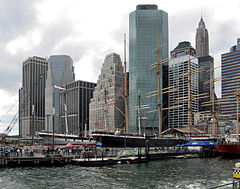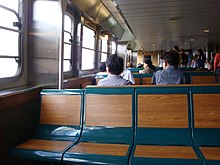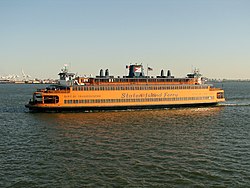Staten Island Ferry
Historically, the Staten Island Ferry has charged a relatively low fare compared to other modes of transit in the area; and since 1997, the route has been fare-free.
He competed against other boatmen providing service in the harbor, who called him "Commodore" because of his youthful eagerness; although the nickname was intended to be jocular, it applied to him for the rest of his life.
[6] Around the same time, U.S. Vice President Daniel D. Tompkins secured a charter for the Richmond Turnpike Company as part of his efforts to develop the village of Tompkinsville, which would become Staten Island's first European settlement.
[7][11] The Richmond Turnpike Company began to operate the first motorized ferry between New York and Staten Island in 1817,[12] Nautilus, which was commanded by Captain John DeForest, the brother-in-law of Cornelius Vanderbilt.
[38][39] On September 17, 1872, the property of the company was sold to George Law in foreclosure,[38] with the exception of the ferryboat Westfield II, which was purchased by Horace Theall.
[68] On February 21, 1902, two hundred people held discussions with MacDougal Hawkes, the head of the New York City Department of Docks, to demand that the Whitehall-to-St. George ferry service be improved.
[70][71] Throughout the rest of the year, Rogers's Standard Oil-affiliated transit venture, which also operated streetcar routes on Staten Island, competed with the B&O for the rights to the ferry.
Instead of offering the franchise to either the B&O or Rogers, the Sinking Fund Commission decided, in March 1903, that the city could run two ferry routes from Staten Island.
[76] The bill authorizing the city to acquire ferry operations was passed by the 126th New York State Legislature, and it was signed into law by Governor Benjamin B. Odell in May 1903.
[89] The ferry service from St. George to 39th Street in Sunset Park, Brooklyn, became city-operated on November 1, 1906,[90][46] as provided for by the 1903 law transferring ownership of that route to the city.
[100] Another vessel in the fleet, Castleton, was sold to a private owner in 1915; its classmate, Robert Garrett (renamed Stapleton in 1906) would remain in city ownership until 1922.
[107] After Hylan's electoral defeat by Jimmy Walker in 1925, George W. Loft and William Randolph Hearst were respectively renamed to West Brighton and Whitehall II.
[116] In February 1939, the United States Department of Commerce ordered the Brooklyn & Richmond Ferry Company to cease all operations after finding that one of its 40-year-old boats was in a severely deteriorated condition.
[120] After the end of World War II in 1945, the city wanted to reconstruct St. George Terminal, which would in turn improve ferry service to Whitehall Street.
[139] The Midtown ferry proved successful until the city essentially eliminated the competing Whitehall Street route's fare in July 1997, as part of the Metropolitan Transportation Authority (MTA)'s "one-city, one-fare" transfer scheme: Staten Island transit riders could pay a single $1.50 fare with a MetroCard on a Staten Island bus or train and get a free transfer to a Manhattan bus or subway by taking the St. George–Whitehall ferry at no additional cost, with return trips handled similarly.
[150] As a result of the Maritime Transportation Security Act of 2002, all vehicular traffic on the ferry was banned in 2003, and passengers were no longer allowed to board from the lower level of either terminal.
[146] On February 7, 2005, a completely renovated and modernized terminal, designed by architect Frederic Schwartz, was dedicated,[184][185] along with the new two-acre Peter Minuit Plaza in the Battery.
[211] Rudy Giuliani's three-percent margin of victory in the concurrent mayoral elections was in considerable part due to the support of 80% of Staten Island voters, whose concerns he had pledged to address.
[212] The passenger fare was subsequently eliminated altogether, in July 1997, as part of the implementation of the MTA's "one-city, one-fare" system, which allowed for more free transfers between different modes of transit in New York City.
[213] In 2014, the city's Independent Budget Office conducted a study investigating the viability of collecting fares from everyone except Staten Island residents.
[241] The John F. Kennedy, Samuel I. Newhouse, and Andrew J. Barberi are being replaced by three new 310 feet (94 m) vessels:[242][234] SSG Michael H. Ollis, Sandy Ground, and Dorothy Day.
[244] In November 2016, Eastern Shipbuilding was confirmed as the low bidder for constructing the ships,[245] and the shipyard was awarded the contract, with a notice to proceed being received on March 1, 2017.
[245] Deliveries were delayed after Eastern Shipbuilding's shipyard in Panama City, Florida, was severely damaged by Hurricane Michael in October 2018,[247] and again in 2020 due to the COVID-19 pandemic in the United States.
[269] Its two classmates, Kolff (later Walter Keane) and Merrell (later Vernon C. Bain, then Harold A. Wildstein)[272] were shipped to Rikers Island in 1987 to help alleviate prison overcrowding there,[273] to be used as an interim housing solution while new jail facilities were being built.
[290] On November 7, 1978, American Legion crashed into the concrete seawall near the Statue of Liberty ferry port during a dense fog, injuring 173 people on board.
At 7:16 am EDT, it was en route from Staten Island to Manhattan with approximately 2,400 passengers aboard, when it was rammed in dense fog by MV Hoegh Orchid, a Norwegian freighter inbound from the sea to a berth in Brooklyn.
The absence of a gyrocompass, which could have supplemented existing radar capabilities in avoiding collisions, was noted in the February 2, 1982, report by the National Transportation Safety Board.
The doors on the saloon deck were crushed by the slip's adjustable aprons, which a quick-thinking bridgeman lowered to help stop the oncoming ferryboat.
[296] On October 15, 2003, at 3:21 pm EDT, Andrew J. Barberi collided with a pier on the eastern end of the St. George ferry terminal, killing 11 people, seriously injuring many others, and tearing a huge gash in the lowest of the three passenger decks.
On July 1, 2009, at 7:09 pm EDT, Sen. John J. Marchi lost power and hit a pier at full speed, resulting in 15 minor injuries.




















